
“i just lick that shit. then i know!“
ramble warning… obviously.
i want to connect downloaded “content”, resentment, ruins, folk music and circuit design. i know it isn’t going to work out, because i don’t know fuck all about anything. but i suspect that there is a red thread spun through those things. i can feel it. but there’s no physical evidence… none at all. how to connect such emotional stuff to cultural artifacts… and technology? it’s always these questions for me. the words of my mother echo in my head too: “does this need to be asked or said? do you need to say it? if you don’t have anything good to say, why say it?” etc. i hate when she says that shit. especially when she’s right. but here goes nothing…
i suspect that this thread is made of deja vu and nostalgia, perhaps with a touch of melancholy? and whatever pattern recognition mechanism humans have that underlie the experience of deja vu, or a longing to relive something, innocently, as if it never happened before… lizard brain pattern recognition with just barely enough sentience to mock intelligence.
i suspect what i am looking for is an example of some correlated mechanism between the actual and the virtual. a Kantian form, with soft buttons. a mechanism that we have modeled. in our behavior. in our machines. and that’s about memory, with all of the issues that that entails. that there is something about human memory, dreams, reminders, calenders, lists of things to do, procrastination, repetitive stress, and digital memory, that are similar and we recognize it. it’s familiar. and there are emotions involved. in this case, the interesting bit is the negative feelings… anger, envy, despair, fear. but i am particularly interested in resentment. the long term grudge… about? i suspect it is against the passage of time. like bad reverb. one that nostalgia in particular makes a plaintive cry in opposition… why? what’s in it for me?
the resentment is simply my own, for mainstream society and it’s sometimes cruel restraints, and poor behavior around change and transition. and maybe for having been bullied as a kid? if you’re a bully, i have a dream where you experience karma with interest. shylock interest. that’s 25% motherfucker. don’t be late. i know it rarely happens, but one can dream.
resentment for the present is something i am especially curious about. i see it everywhere, and in myself on occasion. it’s not something to be proud of, but living in the past, or for the future, at the expense of the present is a very strange way to live. most people seem to have no problem with it at all! religion and economics are often obsessively fixated on the past and future (sex, death, sin, profit and taxes), in a way that has brought about nightmares for the planet and it’s living things, right now… over the years. it makes me feel extra fucking paranoid about religion and economics! and justifiably righteously angry! but it’s a part of humanity none of us can apparently avoid. as secular or scientific as you might be, the tin foil hats outnumber you 100 to one. and when it comes to connecting to the flow of information, the internet has resources to give access to the entire written history of the planet! but what gets mainly downloaded is porn, memories and entertainment. crazy fucking misinformation, too. it’s a great age for aluminum foil.
audiophiles are notoriously fixated on the past… but also on a strange idea of “progress”. to be left behind is unforgivable. so there’s some built in tension there. but i want to dig a little deeper into the content side of things. not so much with the technology. there’s a glitchy repetitive flourish that one can see on the street… in mass transit… waiting for a tinder date… for takeout. or, at home.
there’s something so familiar about the way digital memory is accessed… i see the way my ex-wife and friends, – especially my kid (!), tear through their smartphones looking for some chestnut. some old feeling, in headphones, again. repeat. Salomon Burke on repeat…. Glen Gould “Goldberg”. Dee Lite, “Groove is in the Heart”. Otis Redding… my daughter is obsessed with animé musical openings… is that even music? what is it about the virtual nature of “music” as it exists now, that so easily elicits such natural memory play? the analog experience for me is so different. way more physical and located in the present. even the ritual of spinning up an LP goes against the inner turnings. it’s so much here and now! but i am a digital immigrant. my kid and her peers and superiors, are digital natives. even my wife has a leg up on me with the hot apps (clubhouse). i would never repeat play anything, unless i was learning a part to perform… and it would be a completely deconstructed experience then. not a crumb of reference or physical memory involved at all. just bones and bits. the emotion comes later… and to repeat it it would diminish the experience.
i think about Wim Wenders “Bis ans Ende der Welt” (“until the end of the world”) and that desire to experience one’s dreams, again and again… or even to see someone else’s dreams. like in movies! the near death experience and the dreamlife are somehow mirroring each other, as well. there is an uncanny similarity between these images and the act of cruising a playlist. clearly it is a human predisposition.
and what the fuck “folk music”! wtf! isn’t that just the most absurd arrogant fucked up moniker for anything?! for who? for fucking what?! there was a time when such music had nothing to do with folksiness. who decided time was up for that? a time when it was simply music for someone! and not fucking Woody Guthrie or Pete Seeger. not that i have anything against that stuff… i love Guthrie, actually. or Howling Wolf. who doesn’t love Howling Wolf? but call it folksy and i am no longer responsible for the consequences.
folk music is ruins. roman ruins. plaster facades… abandoned amusement parks. ghost towns. sometimes like the ones Walter Benjamin was talking about. i have never been to Disney World. but when i went to Lotte World (the chewing gum playland in Seoul) it was in many places revealed by the cracked and beaten fiberglass… to be a fake, virtual faked fantasy, of a really strange little cartoon girl that never existed. with so much generalized effort put into the fantasy, it’s difficult not to want to dance and sing in astro-turf Alpine fields. and do loopty loops on the rollercoaster! but it was a Brechtopalypse! if such a concept exists? it wasn’t ever really possible to forget the fakeness, and it was still ok. there was a lot of gum stuck under the merry-go-ride horse.
clearly, “folk music” is a ruin. we can revisit that graveyard over and over again, too. i will on occasion take grief off the shelf, for a little visit. there are those you don’t want to forget. ave atque vale! but whatever the fuck “folk music” is… there’s a carny tent in our mind, that we never went to. with fake gum stuck under the benches. the grief is only “like grief”. the romance, with romance itself. they’re waiting in the tittie tent for the tractor pulls to start, popping black beauties and settin the woods on fire, not. i think this analogy can be extended to nearly all categorized music to some extent. take your fucking pink floyd and get the fuck out! take your motor bong with you and don’t let the door hit you in the ass.
in the late 90’s to early aughties i collaborated with one of my dearest friends, the artist Melinda Brown, to make happenings at “the Rock”, which was her gallery on 13th street and 9th ave. in the West Village. yes, there was a rock on the sidewalk, just outside. i called it “3rd Millenium Folk Music”… and it continued in Hoboken at the loft i lived in at the time (NY Noise was also held there). it’s a project i would continue if i had the resources… if there was a way to eliminate any and all nostalgia from the idea of “folk music”, what would it become? the poets and musicians came, and it was fabulous to see and hear. but, to be fair, John Belushi did it first. credit where it’s due.
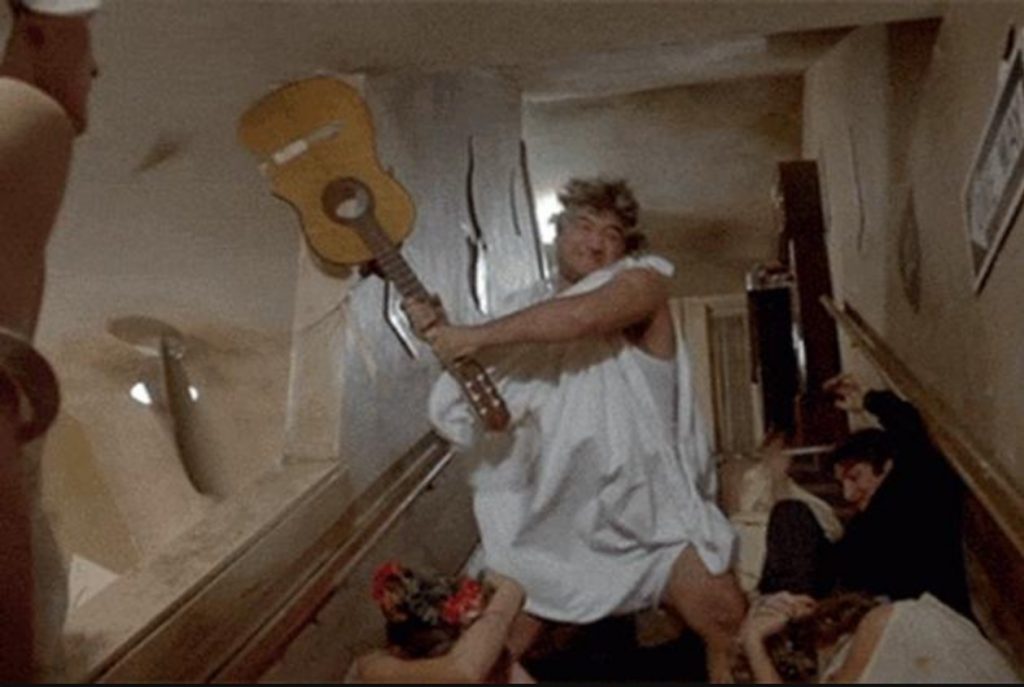
i was listening to the Kasai Allstars. i LOVE that music. they were initially known under the rough label of “congotronics”, where they have had a couple of decades long presence, roughly. a kind of slick hipster pidgeonhole that made them easier to sell to the EDM and “world music” scene. don’t even get me started on “world music”. i don’t imagine congotronics is old enough yet to warrant “folksiness”, slick enough for EDM, or any other marketing ball and chain. highly recommended to check out that scene! they are brilliant musicians and have pulled off a kind of a miracle in linking the cultural histories that have generally been at war with one another around Goma, in the Congo. they really are ferocious. and magnificent! but they are here, now! there’s no smell of musty decay or old wood around their sound. yes there’s a foot in the past, but the other in a future that is still unfolding. there’s no nostalgia or deja vu, possible. that music has never happened before.
the seat of memory and emotional processing in the brain has been identified scientifically as the amygdala.
The amygdala (/əˈmɪɡdələ/; plural: amygdalae/əˈmɪɡdəli, -laɪ/ or amygdalas; also corpus amygdaloideum; Latin from Greek, ἀμυγδαλή, amygdalē, ‘almond’, ‘tonsil’[1]) is one of two almond-shaped clusters of nuclei located deep and medially within the temporal lobes of the brain’s cerebrum in complex vertebrates, including humans.[2] Shown to perform a primary role in the processing of memory, decision-making and emotional responses (including fear, anxiety, and aggression), the amygdalae are considered part of the limbic system.[3] The term amygdala was first introduced by Karl Friedrich Burdach in 1822.[4] (from wikipedia)
i always thought queen amygdala was a star wars character. like luke’s mom… or some shit?
“In one study, electrical stimulations of the right amygdala induced negative emotions, especially fear and sadness. In contrast, stimulation of the left amygdala was able to induce either pleasant (happiness) or unpleasant (fear, anxiety, sadness) emotions.[10] Other evidence suggests that the left amygdala plays a role in the brain’s reward system.[11]
Each side holds a specific function in how we perceive and process emotion. The right and left portions of the amygdala have independent memory systems, but work together to store, encode, and interpret emotion.
The right hemisphere of the amygdala is associated with negative emotion.[12][13] It plays a role in the expression of fear and in the processing of fear-inducing stimuli. Fear conditioning, which occurs when a neutral stimulus acquires aversive properties, occurs within the right hemisphere. When an individual is presented with a conditioned, aversive stimulus, it is processed within the right amygdala, producing an unpleasant or fearful response. This emotional response conditions the individual to avoid fear-inducing stimuli and more importantly, to assess threats in the environment.
The right hemisphere is also linked to declarative memory, which consists of facts and information from previously experienced events and must be consciously recalled. It also plays a significant role in the retention of episodic memory. Episodic memory consists of the autobiographical aspects of memory, permitting recall of emotional and sensory experience of an event. This type of memory does not require conscious recall. The right amygdala plays a role in the association of time and places with emotional properties.[14]” (from Wikipedia).
an interesting summary!
i suppose that means the index finger has it’s hold not just on the select “button” on yer touch screen, and the well of nostalgia and melancholy waiting there… but also on the consequences. the aftermath. the afterglow. the oxytocin. the endorphin. the index finger is also the trigger finger, how we point out directions, and the first sex toy!
when Mingus wrote “all the things you could be by now if sigmund freud’s wife was your mother…” he was thinking about how “All the Things You Are” (Kern and Hammerstein) which has the same bones as work by Bach, Pergolesi, Purcell – to Charlie Parker, Ellington… and Mingus (and many others)! it’s a circle of fifths progression with some twists unusual for pop music. it became a fundamental component for composition and improvising in the 1940s and 50s.

this was known as a “contrafact” back in the day. a term that never caught on but is a basic technique of classical music. and jazz. and the bones of the composition can create a kind of deja vu and pattern recognition we can find inside and out of jazz. much jazz composition and improvisation is built on the memory play of references and the underlying structure of diatonic music… common to most “western” music since it began at the end of the dark monotonic ages. all of it can be reused and re contextualized and Mingus demonstrates the principles in this particular piece with flair. it’s a fabulous piece. and the initially hyperbolically incongruous melody ties bebop to all the rest of it. i love Mingus. Mingus and Ellington are america’s greatest composers, so far. i am certain more are coming! we are so early into the 21st century…
right, so where am i? oh yes! i am failing to provide any evidence for the supposition that digitally downloaded music, “folk music”, ruins, and circuit design are all connected, maybe by nostalgia and deja vu… resentment for the present and memory processing. as perhaps in the amygdala. i wonder if a CODEC is a simplified functional electronic amygdala, just waiting for a conscience and to be diddled with an index finger?
i once went to visit my father at the air force psychiatric hospital he lived in near Biloxi Mississippi. i had not seen him for some time and had felt that i should probably never see him again. but my first wife and i went there together and made plans to sign him out and take him to the Heritage Jazz Festival in nearby New Orleans. it was a generous effort and not without love. i was born in NOLA. my father did his PHD at Tulane and my mother was also born there. we lived somewhere among the “fruit streets” near Audubon Park but i was too young to remember exactly where. long before smartphones… but we were wandering around looking for someplace to eat and we got lost for a second. then there was this tree, an enormous gnarled old scaly ancient… and i just froze. it was like looking at something for the first time, but long ago. through the eyes of a child. despite the changes of time, it was my tree. my house. my street. but i hadn’t been there since i was four. it was a disruptive uncomfortable and intensely non-verbal emotional shock to see it. and it took some time to sort out the feelings and give it words. but i could hardly breathe at the time.
the exact opposite of the experience of downloading an old fave.
so i haven’t sorted out anything. i haven’t explained it or made a case for anything.
i have failed again.
some years ago i posted a circuit of mine cantankerously dubbed: “evil metal band name generator”. i have oversized pride in that circuit. it is a good one! but i seriously doubt anyone gives a flying fuck about it! there’s no nostalgia involved, but perhaps a little melancholy? i didn’t have time to do much more than prove the concept, until recently. but today i want to share some of the branching variations of EMBNG. for me, this design is contrarian victory against the forces of homogeneity and boredom. a revenge against the sloth.
below you see a new arrangement. most people will see an attenuator, followed a buffer, with a ground based reference. it is none of those things. actually, this is gain stage with feedback giving a gain of 10. however, simply by changing R3 to 2 megohms, makes this a gain stage with a gain of 100. if you were to use a photocell optocoupler in place of R3, and vary the resistance between 600 ohms and 2 megs, you have a stable variable gain amplifier with a gain of -6dB to +40dB. all made with 10 parts. yes, this kind of “displaced reference” (to quote my friend Bjørn Kolbrek) circuit just fills me with joy.
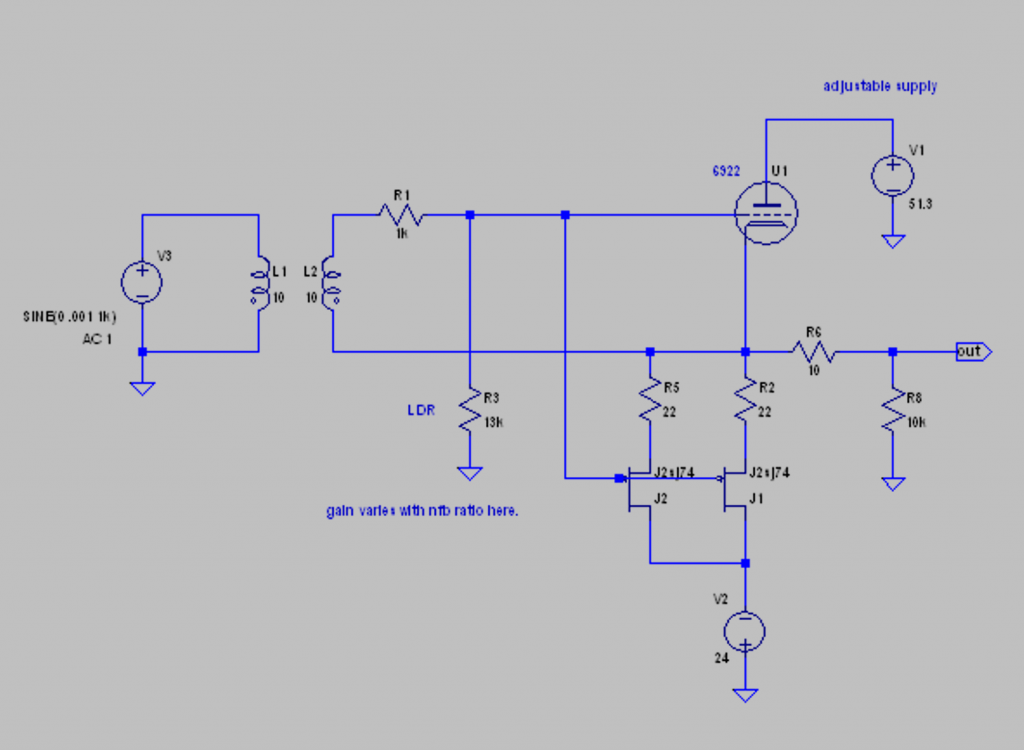
below you see the sweep of the above circuit.

and below this you have a sweep with R3 = 1 meg

this is another case of a flying input type circuit, or “bootstrapped” circuit, but with a hybrid complimentary reference at the output. the hybrid push-pull amplifier stage does not look capable of any gain… but because the 6922/2SJ74 generator is free to swing on it’s own mu against the floating secondary of the input transformer, it very much does so. some will recognize the 6922/2SJ74 stage from the hybrid buffer of many posts earlier. in this case, the same combination behaves differently. the output impedance is not so low… but is the quotient of the tube/FET plate resistance in parallel. the transconductance for the pair is used for gain because this is equivalent to a push-pull grounded cathode/grounded source amplifier, and NOT a grounded plate. and the input side ground reference, R3, completes a feedback loop to the input of the gain stage. there is a document in the “references” page of labjc.com from the 4th edition of the RCA “Radiotron”, which basically describes these kinds of “bootstrap” circuits… so the idea is not new. just seldom used in commercial or diy audio. and not like this! i am absolutely sure this has never yet found it’s way into commercial work anywhere, or even barely discussed, until now.
the original EMBNG circuit was also a bootstrap gainstage like this, but with a pentode. the screen return that allowed full pentode gain is the most fun detail. that has most definitely never been done before, because there is the ordinary problem of the screen needing a reference to the cathode. with the cathode flying around, and a fixed screen and plate voltage, you get triode gain. i ran into this with trying to work out folding a bootstrapped cascode with a pfet and pentode, with the screen and plate grounded. it worked well, but only triode gain. but once the screen and plate currents were arranged in the right relation to the cathode, it became a pentode again. and the pentode could be loaded with a current source, to create a simple e/i conversion. a voltage in produced a current out, at a rate of the change of the transconductance of the pentode. the gain is extremely high… along with the output impedance. just like i like it! look below:
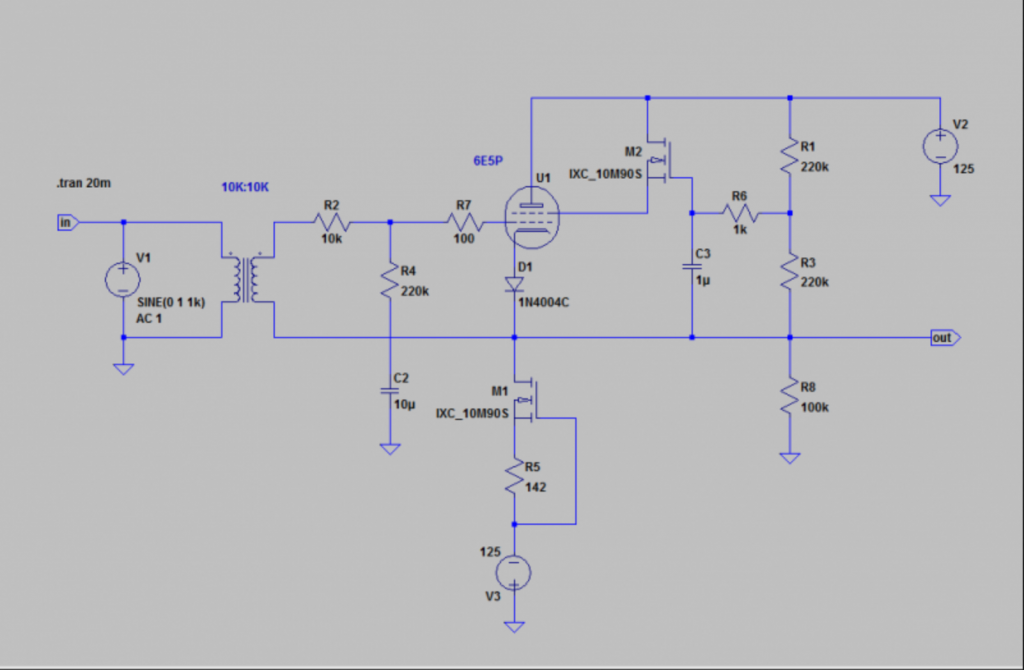
the gain of the above circuit is +26 dB as shown. but is adjustable via R4. the output flies with mu gain, but can’t at the pentode input by the feedback ratio, A/beta. that is, R2/R4. i needed this for a hybrid output stage without any error correction. open loop gain is about +90 dB peaked. the peak is because of the transformer secondary impedance and R2. because of the feedback, any and all gain is just going to help… i welcomed the opportunity. C2 was necessary because i tested this without being particularly worried about what happened next. so the output can and will have some offset without some additional effort to hold it at 0 Volts DC. but the floating nature of the circuit also invites drift from aging and noise from a less than perfectly filtered supply. i started to think about servo circuits and DC feedback… and also if M1 could be a “P” type device and still bootstrap the secondary of the transformer. why not! Stefano Bae and i have been working out extensions of these bootstrap circuts now, in products.
in the Silbatone RI-25, the first stage was also a bootstrap circuit, but “upside down”, with the plate grounded. this allowed a direct coupled circuit that kept the signal close to ground… which made it safer. the B+ was over 1000 volts DC. but the choice of input transformer was critical in that design. and dual tubes rolled off the highs too much. we figured out eventually that the heater circuit was the culprit. floating cathode and heaters and capacity of the input transformer all conspired together. individual tubes and heaters were a must. so i tried to imagine grounding, for AC, the input… but that introduced a negative feedback loop from the output back to the input! which was even more enjoyable because it looked like a ladder attenuator. it is and it isn’t!
to improve the older design, i wanted to change the first stage of the RI-25 to a split supply output, with the signal near ground, that could drive a large power tube to full power directly. all of the gain is needed to be in one stage. you can see the RI-25 below. a transconductance amp with a pentode, a buffer with a large swing and a floating input could replace the first two stages of the design with lower distortion and only local error correction. and still direct coupled within the input and output transformers. no global feedback.
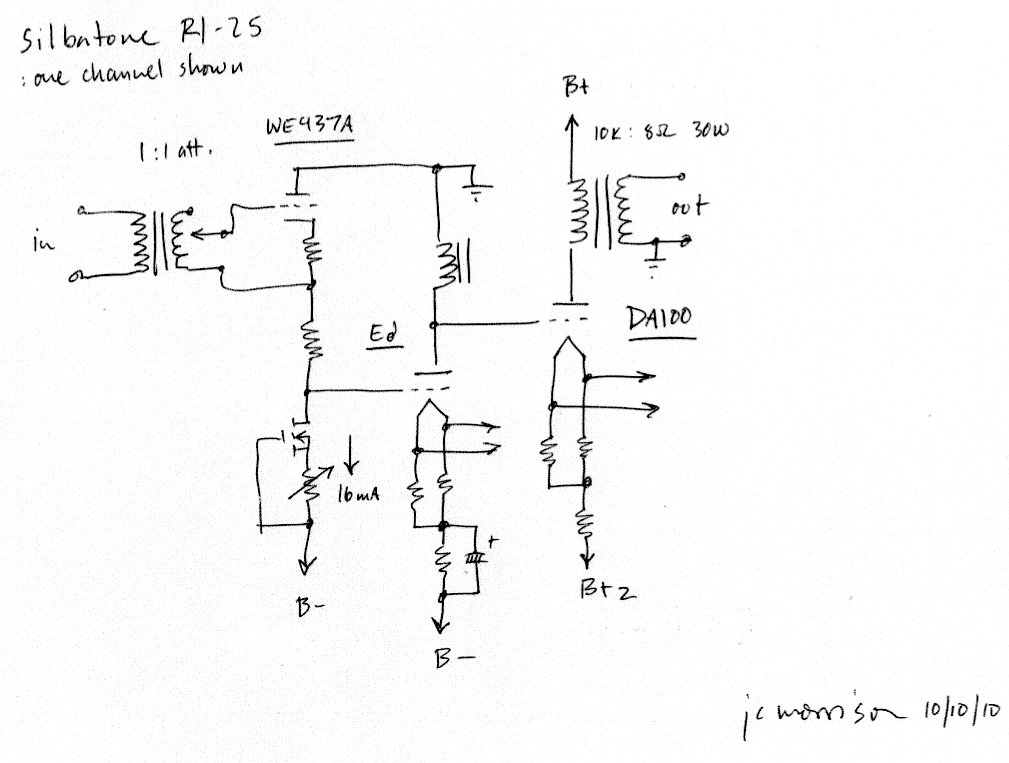
that’s the history of these circuits. what i still need for the updated RI-25 circuit is a buffer worthy of the first stage. i have a few. below is an enhanced cathode follower that can swing 480 volts pp at insanely low distortion. this might be of interest for some with a thought to push pull class AB or B designs? the circuit is based on ideas published in the article “Some Augmented Cathode Follower Circuits”, by J. Ross Macdonald. a brilliant reference every DIYer worth their salt should read. i will post the article in the references. it’s a classic! have a look below for my arrangement. you will see the similarity and perhaps the difference too?
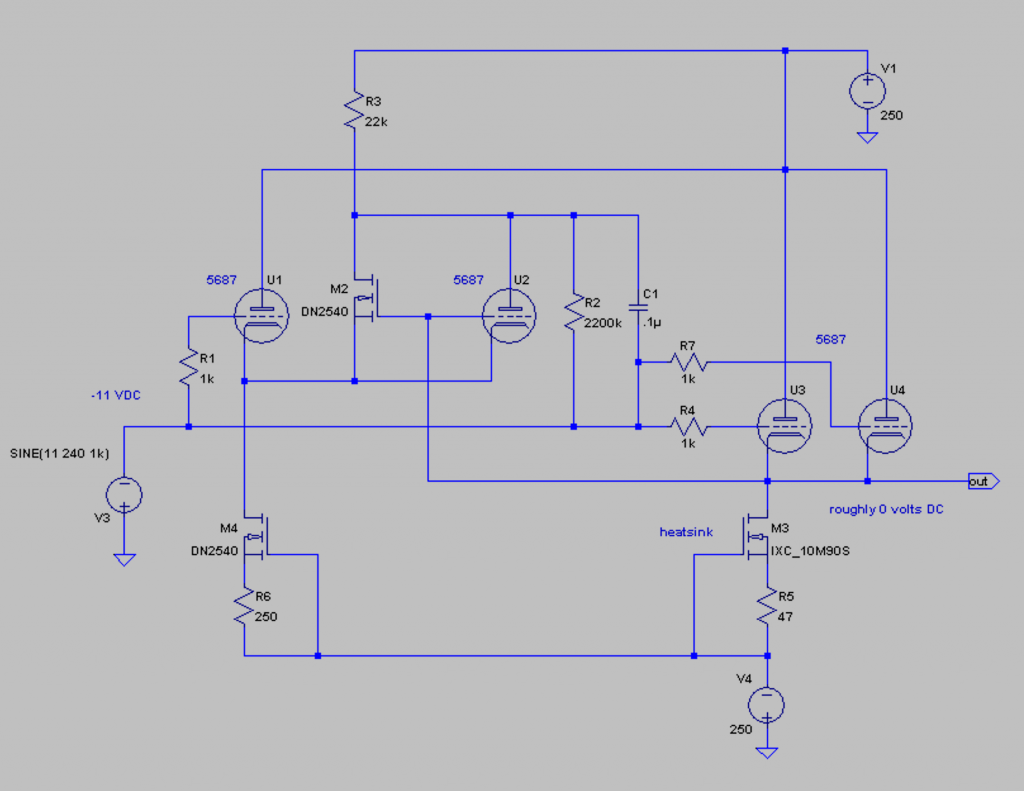
below is the output. please note the insane large signal range with low distortion.

below is the sweep.

below is the fft. it is very very good. all that crap to the right is a simulation artifact.
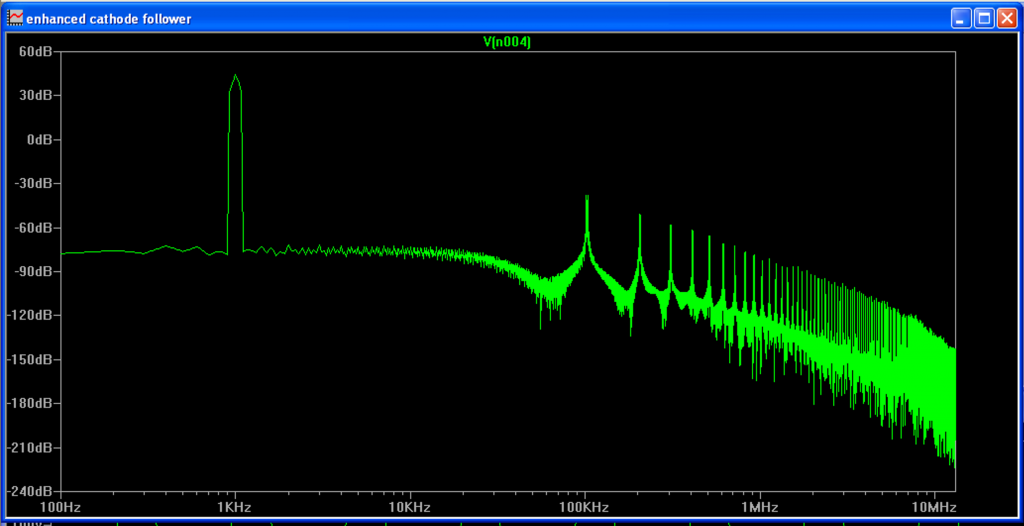
the input can be offset + or minus 50 volts without any changes to the design. it will shift the output voltage accordingly. but this could also be used to bias an output tube. while not a simple buffer, it offers extreme performance.
okay, that’s enough for today. hopefully food for thought, since nothing else worked out…